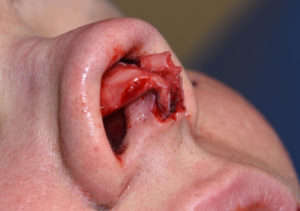Rhinoplasty surgery requires incisional access to perform osteocartilaginous reshaping. The most common historic technique was the ‘closed approach’ where all incisions were placed inside the nose. Because this provided limited visual access it took a lot of experience to master aesthetic nasal surgery. This was the standard in rhinoplasty until the 1990s were it was surpassed in usage by the ‘open approach’.

Patients are often understandably concerned about a visible nasal scar with the open nasal approach. But the columellar skin heals so well that such a scar is virtually invisible in most patients. It rarely causes a scar problem and I have never seen a hypertrophic or keloid columellar scar. The only occasional columellar scar problem seen is a stepoff or notch along one of its sides due to less than perfect closure or premature incisional separation.
Interestingly, the widespread use of the open approach has led to a re-emergence of the closed approach. Now known as the ‘scarless’ rhinoplasty, the use of the closed approach is refinding a role in certain types of nasal reshaping surgeries.
Dr. Barry Eppley
Indianapolis, Indiana


